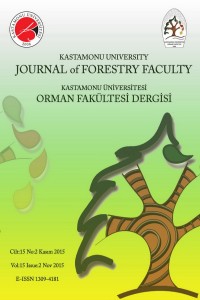Öz
In this study, thermoplastic starch based polymer composites were manufactured using lignocellulosic filler (wheat straw flour) and polymer matrix (policaprolactone) through extrusion and compression molding. Thermoplastic starch based composites were foamed using microcellular foaming technology. Densities of the foamed samples were determined. Morphologies of polymer composites were studied using scanning electron microscopy (SEM). Before foaming, solubility and diffusivity of manufactured composites were measured. According to test results, solubility of composites were reduced with the increase of PCL loading but diffusivity values of composite samples were decreased with PCL loading. Parallel to increase of PCL loading, both composite samples are found better foaming with policaprolactone loading and density reduction of the foamed samples was reduced
Anahtar Kelimeler
Kaynakça
- Karakuş, K., Nişasta Esaslı Biyolojik Olarak Bozunabilen Odun Polimer Kompozitlerin Üretimi Ve Mikro hücre Yöntemiyle Köpüklendirilmesi, Doktora Tezi, Kahramanmaraş Sütçü İmam Üniversitesi, Fen Bilimleri Enstitüsü, 2012.
- Liu, D., Zhong, T., Chang, P.R., Li, K., Wu, Q., “Starch Composites Reinforced by Bamboo Cellulosic Crystals”, Bioresource Technology, Cilt 101, 529–2536, 2010.
- Dintcheva, N.T., La Mantia, F.P., “Durability of Starch-based Biodegradable Polymer”, Polymer Degradation and Stability, Cilt 92, 630-634, 2007.
- Curvelo, A.A.S., De Carvalho, A.J.F., Agnelli, J.A.M., “Thermoplastic Starch-Cellulosic Fibers Composites: Prelimary Results”, Carbonhydrate Polymers, Cilt 45, 183–188, 2001.
- Özsağıroğlu, E., Enzimatik Polimerizasyon ile Sentezlenen Polikaprolakton Reaksiyon Koşulları Etkisinin ve Polikaprolaktonun Biyobozunurluğunun İncelenmesi, İTÜ, FBE, İstanbul, 2011.
- Mengeloğlu, F., Karakus, K., “Some Properties of Eucalyptus Wood Flour Filled Recycled High Density Polyethylene Polymer-Composites”, Turk J Agric For., 32, 537-546, 2008.
- Panthapulakkal, S., Law, S., Sain, M., “Injection Molded Hybrid Natural Fiber Composite Materials for Automotive Applications”, SAE Paper No, 2004-01-0014, 2004
- Sain, M., Li, H., “High stiffness Natural Fiber-Reinforced Hybrid Polypropylene Composites”, Polym. Plast Technol Eng. Cilt 42, No 5, 853-862 2003.
- Mengeloğlu, F., Karakus, K., “Mechanical Properties of Injection-Molded Foamed Wheat Straw Filled HDPE Biocomposites: The Effects of Filler Loading and Coupling Agent contents”, Bioresources, Cilt 7, No 3, 3293-3305. 2012.
- Matuana, L.M., “Solid State Microcelllular Foamed Poly(lactic acid): Morpholgy and Property Characterization”, Bioresource Techn., Cilt 99, 3643-3650, 2008.
- Matuana, L.M., “Study of Cell Nucleation in Microcellular Poly(lactic acid) Foamed with Supercritical CO2 through a Continuous-Extrusion Process”, Ind. Eng. Chem. Res., Cilt 49, 2186-2193, 2010.
- Di, Y., Iannace, S., Di Maio, E., Nicolas, L., “Reactively Modified Poly(lactic acid): Properties and Foam Processing”, Macromolecular Materials and Engineering, Cilt 290, No 11, 1083-1090, 2005.
- Patel, S.V., “Dimensional Changes of Starch Mikrocellular Foam During the Exchange of Water with Ethanol and Subsequent Drying”, Bioresources, Cilt 5, No 1, 121-134, 2010.
- Gangjian, G., Development of Fine-Celled Biofibre Composite Foams using Physical Blowing Agents and Nanoparticle, Degree of Doctor of Philosophy, University of Toronto, 2006.
Öz
Bu çalışmada, termoplastik nişasta içerisine dolgu maddesi olarak buğday sapı unları ve polimer matris olarak biyobozunur polikaprolakton (PCL) kullanılarak polimer kompozit malzemeler üretilmiştir. Polimer kompozit malzemelerinin üretimi ekstrüzyon ve pres kalıplama yöntemi ile gerçekleştirilmiştir. Üretilen kompozit örnekleri mikro-hücre yöntemi teknolojisi kullanılarak köpüklendirme işlemine tabi tutulmuştur. Köpüklendirilmiş örneklerin yoğunlukları tespit edilmiş olup taramalı elektron mikroskobu yardımıyla (SEM) morfolojik özellikleri belirlenmiştir. Köpüklendirme işleminden önce kompozit örneklerin gaz tutma ve gaz çıkış hızı değerleri belirlenmiştir. Sonuçlar incelendiğinde PCL oranındaki artışa bağlı olarak örneklerin gaz tutma kapasitesinde önemli oranda bir artış, gaz çıkış hızı değerlerinde ise PCL oranındaki artışa paralel olarak bir azalma meydana gelmiştir. PCL oranındaki artışa paralel olarak köpüklendirmenin daha iyi olduğu ve düşük yoğunluklu örneklerin üretilebildiği tespit edilmiştir.
Anahtar Kelimeler
Köpük Mikro-Hücre yöntemi Nişasta Polimer biyokompozit Taramalı elektron mikroskobu (SEM)
Kaynakça
- Karakuş, K., Nişasta Esaslı Biyolojik Olarak Bozunabilen Odun Polimer Kompozitlerin Üretimi Ve Mikro hücre Yöntemiyle Köpüklendirilmesi, Doktora Tezi, Kahramanmaraş Sütçü İmam Üniversitesi, Fen Bilimleri Enstitüsü, 2012.
- Liu, D., Zhong, T., Chang, P.R., Li, K., Wu, Q., “Starch Composites Reinforced by Bamboo Cellulosic Crystals”, Bioresource Technology, Cilt 101, 529–2536, 2010.
- Dintcheva, N.T., La Mantia, F.P., “Durability of Starch-based Biodegradable Polymer”, Polymer Degradation and Stability, Cilt 92, 630-634, 2007.
- Curvelo, A.A.S., De Carvalho, A.J.F., Agnelli, J.A.M., “Thermoplastic Starch-Cellulosic Fibers Composites: Prelimary Results”, Carbonhydrate Polymers, Cilt 45, 183–188, 2001.
- Özsağıroğlu, E., Enzimatik Polimerizasyon ile Sentezlenen Polikaprolakton Reaksiyon Koşulları Etkisinin ve Polikaprolaktonun Biyobozunurluğunun İncelenmesi, İTÜ, FBE, İstanbul, 2011.
- Mengeloğlu, F., Karakus, K., “Some Properties of Eucalyptus Wood Flour Filled Recycled High Density Polyethylene Polymer-Composites”, Turk J Agric For., 32, 537-546, 2008.
- Panthapulakkal, S., Law, S., Sain, M., “Injection Molded Hybrid Natural Fiber Composite Materials for Automotive Applications”, SAE Paper No, 2004-01-0014, 2004
- Sain, M., Li, H., “High stiffness Natural Fiber-Reinforced Hybrid Polypropylene Composites”, Polym. Plast Technol Eng. Cilt 42, No 5, 853-862 2003.
- Mengeloğlu, F., Karakus, K., “Mechanical Properties of Injection-Molded Foamed Wheat Straw Filled HDPE Biocomposites: The Effects of Filler Loading and Coupling Agent contents”, Bioresources, Cilt 7, No 3, 3293-3305. 2012.
- Matuana, L.M., “Solid State Microcelllular Foamed Poly(lactic acid): Morpholgy and Property Characterization”, Bioresource Techn., Cilt 99, 3643-3650, 2008.
- Matuana, L.M., “Study of Cell Nucleation in Microcellular Poly(lactic acid) Foamed with Supercritical CO2 through a Continuous-Extrusion Process”, Ind. Eng. Chem. Res., Cilt 49, 2186-2193, 2010.
- Di, Y., Iannace, S., Di Maio, E., Nicolas, L., “Reactively Modified Poly(lactic acid): Properties and Foam Processing”, Macromolecular Materials and Engineering, Cilt 290, No 11, 1083-1090, 2005.
- Patel, S.V., “Dimensional Changes of Starch Mikrocellular Foam During the Exchange of Water with Ethanol and Subsequent Drying”, Bioresources, Cilt 5, No 1, 121-134, 2010.
- Gangjian, G., Development of Fine-Celled Biofibre Composite Foams using Physical Blowing Agents and Nanoparticle, Degree of Doctor of Philosophy, University of Toronto, 2006.
Ayrıntılar
| Birincil Dil | Türkçe |
|---|---|
| Bölüm | Makaleler |
| Yazarlar | |
| Yayımlanma Tarihi | 9 Mart 2015 |
| Yayımlandığı Sayı | Yıl 2015 Cilt: 15 Sayı: 2 |


